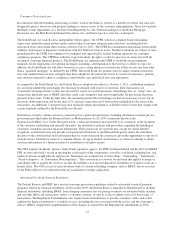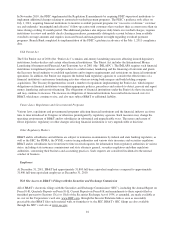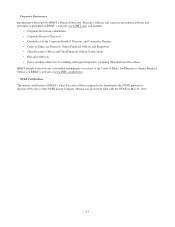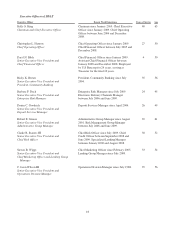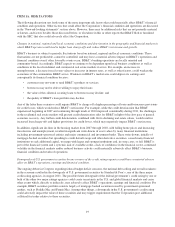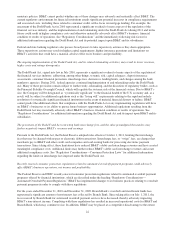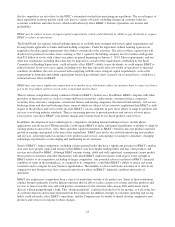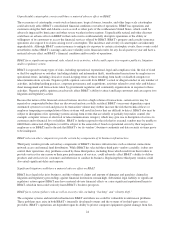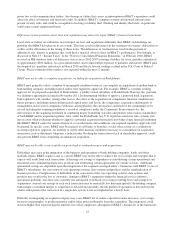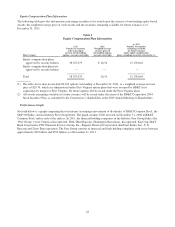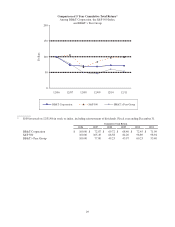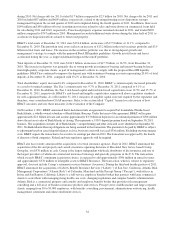BB&T 2011 Annual Report Download - page 22
Download and view the complete annual report
Please find page 22 of the 2011 BB&T annual report below. You can navigate through the pages in the report by either clicking on the pages listed below, or by using the keyword search tool below to find specific information within the annual report.monetary policies. BB&T cannot predict whether any of these changes may adversely and materially affect BB&T. The
current regulatory environment for financial institutions entails significant potential increases in compliance requirements
and associated costs, including those related to consumer credit, with a focus on mortgage lending. For example, the
enactment of the Dodd-Frank Act in 2010 represented a significant overhaul of many aspects of the regulation of the
financial services industry, and the implementation of and rulemaking under the Dodd-Frank Act during 2011 and in the
future could result in higher compliance costs and otherwise materially adversely affect BB&T’s business, financial
condition or results of operations. See “Regulatory Considerations” and the immediately following risk factor for
additional information regarding the Dodd-Frank Act and its potential impact upon BB&T and its subsidiaries.
Federal and state banking regulators also possess broad powers to take supervisory actions as they deem appropriate.
These supervisory actions may result in higher capital requirements, higher insurance premiums and limitations on
BB&T’s activities that could have a material adverse effect on its business and profitability.
The ongoing implementation of the Dodd-Frank Act, and its related rulemaking activities, may result in lower revenues,
higher costs and ratings downgrades.
The Dodd-Frank Act, signed into law in July 2010, represents a significant overhaul of many aspects of the regulation of
the financial services industry, addressing, among other things, systemic risk, capital adequacy, deposit insurance
assessments, consumer financial protection, interchange fees, derivatives, lending limits, and changes among the bank
regulatory agencies. During 2011, federal agencies continued implementation of and rulemaking under the Dodd-Frank
Act. Many of these provisions remain subject to further study, rulemaking, and the discretion of regulatory bodies, such as
the Financial Stability Oversight Council, which will regulate the systemic risk of the financial system. Due to BB&T’s
size, the Company will be designated as “systemically significant” to the financial health of the U.S. economy and, as a
result, will be subject to additional regulations such as the “living will” requirements relating to the rapid and orderly
resolution of systemically significant financial institutions in the event of material financial distress or failure. BB&T
cannot predict the additional effects that compliance with the Dodd-Frank Act or any implementing regulations will have
on BB&T’s businesses or its ability to pursue future business opportunities. Additional regulations resulting from the
Dodd-Frank Act may materially adversely affect BB&T’s business, financial condition or results of operations. See
“Regulatory Considerations” for additional information regarding the Dodd-Frank Act and its impact upon BB&T and its
subsidiaries.
The provisions of the Dodd Frank Act restricting bank interchange fees, and the rules promulgated thereunder, may
further negatively impact BB&T’s revenues and earnings.
Pursuant to the Dodd-Frank Act, the Federal Reserve adopted rules effective October 1, 2011, limiting the interchange
fees that may be charged with respect to electronic debit transactions. Interchange fees, or “swipe” fees, are charges that
merchants pay to BB&T and other credit card companies and card-issuing banks for processing electronic payment
transactions. Since taking effect, these limitations have reduced BB&T’s debit card interchange revenues and have created
meaningful compliance costs. Additional limits may further reduce BB&T’s debit card interchange revenues and create
additional compliance costs. See “Regulatory Considerations—Consumer Protection Laws” for additional information
regarding the limits on interchange fees imposed under the Dodd-Frank Act.
Recently enacted consumer protection regulations related to automated overdraft payment programs could adversely
affect BB&T’s business operations, net income and profitability.
The Federal Reserve and FDIC recently enacted consumer protection regulations related to automated overdraft payment
programs offered by financial institutions, which are described under the heading “Regulatory Considerations—
Automated Overdraft Payment Regulation.” BB&T has implemented changes to its business practices relating to overdraft
payment programs in order to comply with these regulations.
For the years ended December 31, 2010 and December 31, 2009, Branch Bank’s overdraft and insufficient funds fees
represented a significant amount of non-interest fees collected by Branch Bank. Since taking effect on July 1, 2011, the
fees received by Branch Bank for automated overdraft payment services have decreased, thereby adversely impacting
BB&T’s non-interest income. Complying with these regulations has resulted in increased operational costs for BB&T and
Branch Bank, which may continue to rise. In addition, BB&T may be placed at a competitive disadvantage to the extent
22





